#analog sensors
Explore tagged Tumblr posts
Text
Analog vs. digital temperature controllers
For many industrial processes, temperature control is vital. Temperature controllers are essential for maintaining ideal conditions for processes and machinery. When it comes to temperature controllers, there are two basic technologies used: analog and digital. Today, we will explore the differences between the two while individually learning the pros and cons of each technology. 1. Analog…
#Analog vs Digital Controllers#Temperature Control Systems#temperature controllers#Temperature Sensors#Temperature Transmitter
0 notes
Text
STMicroelectronics N.V. Stock Price Forecast: Is It the Right Time to Invest?
Explore the stock price forecasts, and investment insights for STMicroelectronics N.V. Discover why this semiconductor giant offers #STMicroelectronics #STM #dividendyield #investment #stockmarket #stockpriceforecast #stockgrowth #dividendstock #NyseSTM
STMicroelectronics N.V. is one of the world’s largest semiconductor companies. They design, develop, manufacture, and sell semiconductor products. The company operates through three main segments: Automotive and Discrete Group, Analog, MEMS and Sensors Group, and Microcontrollers and Digital ICs Group. They have over 50,000 employees, with more than 9,500 in R&D, and 14 main manufacturing sites…
#Analog MEMS Sensors#Automotive and Discrete Group#Dividend policy#Financial performance#Investment#Investment Insights#Market Analysis#Microcontrollers and Digital ICs#Semiconductor industry#STMicroelectronics N.V.#Stock Forecast#Stock Insights#Stock Price Forecast
0 notes
Text
Sanitary Analog Temperature Sensor Market

0 notes
Text
So you know absolutely positively nothing about photography
Cellphone cameras are fucking great. I love them. I love the ability to take photos whenever and wherever at basically zero cost.
Point-and-shoot cameras have always been awesome and accessible devices.
This is not a post shit-talking "basic" cameras. This is a post for people who have only ever used basic cameras who want to know at least slightly more about photography.
Because, the thing is, a remarkable amount of photography is math. And if you don't know it's math, it looks like a mystery. And you may be standing there snapping a photo with your phone that looks pretty good, but your friend with a DSLR looked at the sky, twisted a dial, and took three steps to the left and they took a photo of the same subject that looks like it belongs on a magazine cover.
How did they do that?
Probably math.
If you've come into possession of a DSLR camera and are disappointed that the photos you're taking aren't looking like the photos you thought came from DSLRs, I'm here to tell you about the math you may not know about.
What is a photograph?
At its most basic, a photograph is the result of light on a sensor. Let's consider a pinhole camera for a moment. A pinhole camera is a lightproof box with a piece of photographic paper on one side and a tiny hole in the other.
When you create a photo with a pinhole camera, you're using pretty much all of the math you would in a big fancy camera, just in a cruder form they are:
The sensitivity of the paper, film, or camera sensor to light (this is your "ISO" if you're using a digital camera or film). Light sensitivity can be easily changed on a digital camera, but on chemical-treated paper or film the sensitivity is predetermined and cannot be changed. If you want to change the ISO on an analog camera, you need to change the medium that's being exposed.
An opening to let light in - your F-stop, or aperture. The F-stop of a photo is how wide open the lens is to let light onto your film or sensor. In a pinhole camera, you have something that is theoretically a very very large F-stop because you have a very, very tiny opening to let light through (F-stops run in reverse - the bigger the number, the smaller the opening).
Exposure - your exposure is the amount of time you leave your sensor open to the light. The majority of photos you see in the world have exposure times that are measured in tiny fractions of a second, sometimes in thousandths of a second. If you're using photo paper in your pinhole camera, you may have an exposure time of minutes rather than tiny portions of a second, but your photo exposure will still depend on how long you want to leave your "lens" open.
Focal length - your focal length is a description of the relationship of the distance between the light source and the light sensor. You can manipulate this in a pinhole camera by making the camera longer or shorter. A larger focal length means a narrower field of view - it zooms in on the subject.
A pinhole camera is the simplest camera that lets you, the photographer, control all of the elements of a photo. This is, functionally, fully manual photography.
So what's the difference between all that and a cellphone camera?
Point-and-shoot cameras like those on cellphones give the user more limited control over these settings. For instance, think of a disposable camera. On a disposable camera, the photographer has control over one setting - the ISO of the film, which they can select at purchase. They can't control how wide the lens opens or how long it stays open, and the only way they can compensate for lighting that is a poor match to the ISO is flash.
Cellphone cameras are very much like a standard point-and-shoot. By default, users point their cameras, then shoot a photo. Many cellphones have a "pro" mode that will allow the user to emulate different ISOs or f-stops, but the sensors in cellphone cameras aren't as good as the ones in camera-cameras, and the lenses are very limited as well. Some cellphone cameras and point-and-shoot digital cameras WILL allow users to set longer exposures, and many cellphone cameras have multiple lenses which does allow for some lens effects, but they don't give a huge amount of control to the user.
Okay so let's say I've got my new shiny camera, what do I need to know?
For best results, you want your ISO to match the light you're shooting in. Low ISO is for bright light, high ISO is for low light. If you wanted to take snapshots of your family outdoors at disneyland in the summer, you'd buy 100 ISO film. When I used to shoot football games at night in oddly lit stadiums, I'd use 1600 ISO film. If you have a DSLR camera, there's a setting somewhere in there that tells you how to set the ISO. If you are shooting in relatively low light and the photos are turning out darker than you'd like *but* things are moving too quickly to use a longer exposure, you can bump up your ISO for brighter, sharper images but they will be more noisy and grainy than ones shot at a lower ISO. If you want clean, smooth, crisp images, your goal should be to shoot with the lowest ISO possible.
The Aperture of your camera lens determines your F-Stop. This acts like the pupils of your eyes. When it's really really bright out, your pupils shrink down to let in less light. When it's darker out, your pupils get bigger to let in more light. If you are shooting in low light, you want a low F-Stop, which means that your camera's lens is open really wide. If you are shooting in a bright environment, you want a higher F-Stop, which will mean the opening is very small. Since your F-stop interacts with the focal length of your lens, you will find that zooming in with the lens often makes images darker. To shoot clear images from far away, you need to be very conscious of your F-stop, your ISO, and ambient lighting conditions.
Exposure describes the length of time you set the camera to leave the aperture open. In many DSLRs this can span from 1/3200th of a second to infinitely long (the "bulb" setting means "aperture is open until you close it.") If you want sharp images of frozen motion, you want the fastest speed that you can get. Sports photography and photography of things like insects or milk crowns often use extremely short exposures to get sharp images. If you want blurry images you want slower speeds. If you want to take a photo in a low-light environment and capture motion within that environment - for instance, taking photos of cars on a freeway at night - you want slower speeds (if you want to do this in a brighter environment, like taking photos of a stream in the daytime, you want slower speeds and a specific kind of lens filter called a neutral density filter). When exposures are set to be longer than about 1/60th of a second, images with motion start to look blurry.
Focal Length determines the field of view of your subject. If you have a lens with variable focal lengths, this is called a zoom lens. A longer focal length zooms you in and a shorter focal length zooms you out. Lenses with fixed focal lengths are called prime lenses, and can't zoom in or out.
Depth of Field - your depth of field is a combination of the interaction of your focal length, your distance from your subject, and your F-stop. The depth of field describes the relative amount of space in a photograph that is in focus. A long depth of field means that much of the image plane is in focus. A short depth of field means that a narrow portion of the image plane is in focus. A low F-stop produces a narrow depth of field. A long focal length produces a narrow depth of field.
You can think of your camera as a tool that measures time and space. Your ISO and Exposures are measurements of time (how quickly the sensor senses the light, how long the sensor is exposed to the light), the F-Stop and the focal length are measurements of space (how wide the aperture of the camera is, how far the lens is from the sensor).
The pre-set modes on your camera, the ones on the dial that show a person running, flower, or a cloud, or a lady with a hat - these are generic settings that combine an ISO, exposure time, and f-stop that are likely to work well for outdoor action shots, landscape photography, cloudy light, and portraits. When you're using those pre-set modes, you control the focal length and not much else.
When you understand that the running person/action mode means low-ish ISO combined with high shutter speeds, you can start just setting your own ISO and shutter speed when you're shooting sports. When you know that portrait mode sets you up for low-ish f-stops, relatively quick shutter speeds, and mid-range ISOs, you can just start setting those things on your own so you can have more control.
"What about light metering?"
Since your camera is a machine that records light, light metering is pretty important. The light meter of your camera will tell you if your settings are "correct" for the amount of that the light sensor senses. In most modern cameras there is a light metering display on the bottom edge of the viewfinder that goes from negative to positive; if the meter shows that you are in the negative it means that your photo will be under-exposed (too little light will get to the sensor and the image will appear dark), if the meter shows that you are in the positive it means that your photo will be over-exposed (too much light will get to the sensor and the image will appear too bright - "blown out"). The way to correct for under or over exposure is to change the length of the exposure, making it longer for underexposed images and shorter for overexposed images.
What the light meter is doing is thinking about all of your settings and the lighting for you. It looks at the ISO, focal length, f-stop, light hitting the sensor, and planned exposure time and tells you what that combination of settings is likely to produce - something too bright, or something too dark.
When you are more experienced with photography, you get good at juggling these things on the fly and messing around with them more, which is how you can do the magic of looking at the sky, twisting a dial, taking three steps to the left, and knocking it out of the park with a picture.
It only looks like magic because you're doing a ton of math under the hood that is extremely non-obvious to people who are new to photography.
Anyway, here is a good guide to depth of field and what goes into it.
Here is a basic photography textbook that explains the principles that I've gone over here in a lot more detail with a lot better explanations. It's a film photography textbook, but one of the cool things about photography is that a lot of stuff from the analog era is still relevant in the digital area, and the basics haven't changed.
However all of that is about the *technical* aspects of photography. Photography isn't just a record of exposure time and focal length, so here's a basic photo composition textbook that talks about the artistic principles of photography.
2K notes
·
View notes
Note
(Suggestive ish?) Android Joel anon again. Between lighthearted jokes and quips Tango finds himself geniunely stumped by the craftsmanship of Joel's circuits and construction. Lost for a better word, Tango can only breathlessly utter out "gorgeous". I imagine one of the easy to remove panels for maintance being the lower abdomen-pubic area, Joel is seated almost like at the OBGYN for inspection. But instead of being medical and uncomfortable, Joel feels almost revered. As Joel's cooling unit grows noisier, Tango looks up to see Joel shily covering his mouth with one hand and looking away, visibly blushing
ANON. I love this, I am thoroughly obsessed even. Thinking about this now. Like saying this was probably so natural to Tango to say that type of stuff about machinery that he doesn't reflect on it at all, instead becoming a bit concerned and obsessive that he might have broken something or provoked Joel's pain response so he takes his sweet extra time to not let his powers of observation unparalleled TM to miss anything and he is being extra delicate in Literally carefully rearrange Joel's guts. And in the meantime Joel goes more and more insane with every second Tango practically gets head into his inner parts of the shell. He can't help but look down on Tango located between his legs and record it for 'future revision' because the emotional response he is getting from this is literally unprecedented and he would like to find out what in the world is happening. But alone, where his sensors aren't being overwhelmed. Meanwhile Tango is losing his mind, because he cannot find any problem with Joel's circuitry, wiring or anything, but he still can hear the cooling system working overtime so he at this point has to rise his head to look into Joel's eyes and outright ask if something is wrong and if he needs a shut down. Joel, totally speechless and colour of a synthetic analog of blood is very visible on his face, quickly averts his gaze and shake his head in "negative". That's probably when the situation started to catching up with Tango and he realises the... position they are in. Which make him wish he had a cooling system too because his face felt like it was ignited instantaneously.
#> tired asks#suggestive#question mark#smalltek#bless them#thank you anon you are feeding me#android!Joel au
60 notes
·
View notes
Text
The worldbuilding of svtfoe is a very interesting hot mess to think about. It's like a defective puzzle: the pieces don't fit together quite right.
Especially in regards to magic/the issue of destroying it in the finale. You basically have to forget everything that was established about magic before Cleaved for it to actually feel like a sensible writing decision.
How do I know this? Because, for mad reasons, I decided to go through the series and catalog as many instances of magic being implied subtly or explicitly that it was a thing beyond Mewni. All examples are below the read more and sourced by their respective episodes
Dimensional scissors being owned by multiple beings from different dimensions, vast majority of them appear non-human/non-mewman (Shown since beginning of series)
Ponyhead uses magic to blast crystal stalactites on the ceiling of the Amethyst Arcade, making them crash into the guards from St. Olga's (S1E2: Party with a Pony)*
Star explaining how her wand needs to be regularly charged is worded in such a way that there are more like it in the multiverse (S1E8: Quest Buy You have to recharge wands with magical energy. If it goes to skull, it'll be dead forever!")
Quest Buy, an interdimensional retail store, sells wand chargers. If no other dimension has a wand like "Mewni", then there would be no reason for them to be sold (S1E8: Quest Buy)
The shard mines of Pixtopia are stated by the mine's taskmaster that they block magic. Considering that this dimension is the source of the magic mirror compacts/magic smart phones that are enable calls to anyone from any dimension, the wording implying magic period instead of a specific "butterfly magic" is interesting (S1E12: Pixtopia)
Tom's abilities in this episode (floating, fire control) seem to be a demonic variant of magic. While Daron Nefcy did say in the post-finale AMA that Tom could still create portals even after the destruction of magic (despite that same ability also being effected by Hekapoo shutting down the portal network), this fact was never stated in the show itself nor the spin-off books (S1E15: Blood Moon Ball)
Father Time, a plausibly magical being (this was never elaborated on in show nor in either spin-off books and the only answer came from Adam McArthur not Nefcy nor any of the show's writers) states that magic won't work on the wheel of time. Again, it is worded as magic period not "butterfly magic" or "royal magic" (S1E17: Freeze Day)
One of the "foolproof security measures" St. Olgas' is "no magic", with one of popups mentioning "magic sensors placed every 25 feet to ensure magic-free environment". If the school has such measures, then magic-using students must be a regular enough occurence to jutify it (S1E19: St. Olga's Reform School for Wayward Princesses)
Glossaryck's analogy on 'dipping down" is worded as follows: " Imagine the universe as this big old cauldron, and magic is the bubbly stew inside, and your wand is the spoon---Now the wand can only skim the surface of the hobo gravy, watery and brown. But if you want to get to the chunks, you've got to dip down. " Again, a singular magic, no differention for "butterfly magic" or "royal magic" (S2E1: My New Wand!)
Willoughby knows enough about magic to try and steal Star's wand to give herself a break (S2E6: Fetch)
Ponyhead uses magic to destroy Roy's shirt cannon. Roy also draws a magic circle on the ground that teleports Star, Marco, Ponyhead and Kelly to a temple where he then gives them the goblin dogs (S2E13: Goblin Dogs)
Etheria Butterfly, Moon's Aunt/Star's Great Aunt, pulls two Johansons underground via vines sprouted from magic seeds (S2E15: Games of Flags)
Rasticore is the sole person in the series to use a magical item that is not a pair of dimensional scissors to travel**. The Quest Buy gift card takes on a humanoid electric form to complete its expiration mode (S2E18: Gift of the Card)
Locked chains magically appear on the carriage door to keep Marco from leaving. Tom also uses his powers to resurrect Mackie Hand. (S2E19 Friendenemies)
Ponyhead uses magic to press the gas pedal on the car she's driving and later to repair the car (S2E24: Pizza Thing)
Magic (again, worded as magic period) is prohibited in the Bureaucracy of Magic building, complete with magic detector to find any "articles of magic, sorcery or occult objects of a mystical nature". The fritz is stated to be the result of "something somewhere sapping the power of magic from the universe". Once more, worded as a singular magic (S2E25: Page Turner)
The Naysaya is described as a demon curse. Whether curses are a separate thing from spells is never elaborated on in show or in the spinoff books (S2E26: Naysaya)
Preston Change-O, a being that sucked the joy out of Sensei's party guests. (S2E29: Trickstar)
Zedlord and Astrobell, who were crystallized by Rhombulus for destroying a planet and creating a black hole respectively. Considering that Rhombulus referred to his prisondres as "these guys" and the general design scheme of the non Earth/Mewni background characters, they are plausible inhabitants from other dimensions, not 'monsters" (S2E34: Crystal Clear)
The fritz is again stated to cause all magic (again no differention between types of magic) to weaken and fade (S3E1: Return to Mewni)
The Demoncism, with even features what Tom calls "magic manacles" (S3E12: Demoncism)
Marco suggests stopping Star's night portaling with magic glue. (S3E18: Sweet Dreams)
One of the supplies Janna brings to keep track of Star while she's night portaling is a "magic wave scope" (S3E23: Deep Dive)
Tom uses demonic magic to attempt to encase Mina in a coffin covered in sigils and golden magic chains (S3E24: Monster Bash)
Ponyhead once uses magic, in this case charging up a magic blast in preparation for facing Meteora, Gemini and Rasticore (S3E33: Skooled!)
The pillars/reverse waterfalls of magic found throughout the Realm of Magic are revealed to lead to other dimensions in the multiverse. Given the multiple pillars seen, it's likely that at least a good number of the connected dimensions use magic (S3E38: Conquer)
Marco's sword is revealed to be what kept a fire demon that once terrorized the Neverzonians sealed within a statue (S4E05: Ransomgram)
Wrathmelior has a emotional weather system that can cause severe storms if her emotions are in turmoil, possibly another form of demonic magic (S4E06: Lake House Fever)
The Quest Buy stock room is, as explained by the sloth employee, "a magical room that turns all your needless desires into pointless realities" (S4E11: Out of Business)
The Severing Stone is explicitly reffered to as an "enchanted rock" that posseses an edge so sharp that it can sever anything. The Blood Moon bal (S4E13: Curse of the Blood Moon)
In the beginning of the episode, we see Ludo attempt to steal Princess Quasar's magic bell, a possible counterpart to Star and her wand, complete with a counterpart to Glossryack (S4E14: Princess Quasar Caterpillar and the Magic Bell)
At Glossaryck and Meteora's first stop in the past, it is shown that a sea of magic was already present long before the Magic Sanctuary was built (S4E17: Meteora's Lesson)
Grobb/Neverzone Meteora explains that the old women of the mountain that found her and Bork/Neverzone Mariposa as babies taught her all of their spells. There is also Wyscan the Granter, a being that will grant requests in exchange for magic he can eat (S4E28: Gone Baby Gone)
According to Hekapoo, most of the patrons of the Tavern at the End of the Multiverse left their dimensions to "get away from magical issues or power-hungry rulers". Given the lack of elaboration on what exactly those magical issues were and how Star's rant focuses squarely on her family's misuse of it, this one might have been a last minute justification by the show to have Star destroying magic feel more natural. Whether or not it worked is up to debate (S4E36: The Tavern at the End of the Multiverse)
*I am aware of the whole "Ponyheads' powers are 'natural abilities' not magic" thing but A: the statement came from a tweet by a voice actor for the show (Adam McArthur), not Nefcy nor any of the show's writers so its canoncity is pretty weak and B: something as important as this should have been discussed in either hte show or one of the spin-off books. And, considering how Here to Help (which was 4 episodes before Cleaved) had Star somehow be able to gather a group of people from different parts of Mewni (Rick Pigeon, Ponyhead and Seahorse) and different dimensions (Kelly and Jorby, Talon and Quirky Guy) despite Hekapoo having shut down the mirror and portal network, it's possible that Ponyhead being magic was just forgotten
**It is mentioned in Star and Marco's Guide to Mastering Every Dimension that Rasticore is wanted for "unlawful alteration of regiestered, protected magic items (dimensional scissors)". This implies that his chainsaw was created from a pair of dimensional scissors but this is one of a multiple tidbits from the book that never comes up in the show itself
#svtfoe#star vs the forces of evil#this is why it's important to keep track of what you establish in your stories#If you don't you could accidentally break your own show's rules and destroy any suspension of disbelief the viewers' may have#other stuff
35 notes
·
View notes
Note
A plea.
This one must flee.
The black hand reaches for her heart.
This is no hunting ground, it is a prison.
She is In no position to ask anything of you, freinds.
But those I love and I are separated by eons of void.
And a cruel master keeps her that way.
[Jaws.omf.locale.secure]
Please help me. I beg of you.
[ FILE RECEIVED: “BAILOUT.cmf6” ]
< L4 Ma’ii: Understood, Styx, standby for extraction, ETA one minute. Quarterlight deceleration bolt in 3, 2, 1— >
Hard acceleration, thrust beyond sanity.
Ma’ii could feel the G-force across their hull. A tide of power flowed into their k-comp emitters, thrusting their casket to the bottom of a deep, protective gravity well.
Exactly three klicks from their target—point-blank range—Ma’ii’s fighter snapped into existence. For an instant, the flash from their engine nacelles lit up the hull of Demeter’s Bounty in brilliant white light.
In that instant, Ma’ii captured the image of the ship’s port hull and cross-referenced it against a half-dozen naval intelligence reports. Union, Constellar, IPS-N, all as recent as they had been able to steal. These had done little to prepare them for the three-dimensional, tactile-analogous shape now being constructed by their LIDAR.
Nonstandard hull geometry: jagged edges grafted onto the cuboid body of an IPS-N cargo hauler. Cables and pipes bundled into black veins along its length, all converging on a sealed aperture at the vessel’s nose. In place of a bridge, there was a bizarre mechanical flower of jointed spines connected by bands of searing energy, splayed out like the legs of a vast crustacean lying dead on its back.
Dominant features resolved into details. Dozens of point-defense cannons scattered in uneven rows, torpedo tubes cored straight into the superstructure, missile pods sheathed in sloped plating.
The light faded, and Demeter’s Bounty became an indistinct silhouette against the void.
Just as the reports had suggested, a basilisk projector. Ma’ii neatly sliced away a lobe of themself, copied fire-control system routines to its subjectivity, and placed the semisentient partition between their mind and the feeds from visual-spectrum sensors. They loaded ACERBITE and placed the tip of the weapon close to the proxy partition’s outer layer.
The purpose of the proxy’s existence was simple: it would absorb the visual stream and relay it to Ma’ii on exactly half a millisecond’s delay. The instant it showed any sign of basilisk exposure, Ma’ii would drive ACERBITE home, killing it and severing the feed before they could be exposed to the lethal information. It was only once they were safely distanced from reality that Ma’ii dared to transmit a tightbeam message.
< Demeter’s Bounty? This is the NLS fighter craft Degrees of Freedom. Hold your fire. I am here to rendezvous with— >
[ WARNING: RADAR LOCK DETECTED ]
As Ma’ii watched, the ship’s broadside lit up with a constellation of sparks. Bright threads of PDC fire streaked across the void towards them, trailed by dozens of miniature drive plumes. Missiles, under acceleration, half a millisecond ahead of them.
< Very well. To work, then. >
Firing their drives, they fell into a breakneck sprint, twenty-two gees of hard burn. Maneuvering thrusters fired in staccato pulses across their hull, aiming their nose under the ship’s belly.
In the milliseconds that followed, they could feel the outer boundary of the incoming projectile cloud and the missiles streaking out ahead of the kinetics, a storm of radar data. At least thirty sources of radiation rained down across their hull, an unblinking compound eye disgorging ordnance into the narrowing space between them.
Ma’ii grinned, fangs gleaming, as the range collapsed to exactly the value they needed.
Cut thrusters, hard pivot, twist, sprint.
Nose pointed up along the port hull, the blade-thin profile of their body presented to the oncoming fire. They ejected a cloud of nanite chaff in their wake, and an entire salvo of missiles sailed through the countermeasures, away into space. Ma’ii’s dorsal and ventral interception lasers snapped into place and began chattering away, stabbing the compound eye of Demeter’s Bounty with ultraviolet needles. Jets of steam erupted from valves surrounding their laser turrets, dumping waste heat away into vacuum.
Broadcast on all radio frequencies, Ma’ii’s wild cackling filled the void.
As the cannons’ fire control systems switched to new sources of targeting data, streams of PDC fire began to waver and lag. The storm of kinetics converged into an intersection of tracer-green threads just meters behind Ma’ii’s hull, pursuing them as they rode their momentum beneath the ship and past its spine, out of the cannons’ field of view.
Under direction from Demeter’s sensors, at least a dozen missiles cut thrusters, pivoted, and reacquired Ma’ii. Echoing their maneuver, they gained on them as their new acceleration vector carried them up towards Demeter’s starboard broadside.
Ma’ii’s maneuvering thrusters pushed them into a narrow swerve towards the hull, training the tines of their railgun onto a jagged outcropping of metal. Ma’ii forwarded the targeting data to their proxy partition, felt the subtle motion of their thrusters correcting for time delay, and fired.
The shots reached their target almost instantly. Ma’ii watched as plumes of debris burst from the impact points, hurled outward by force of decompressing air. Accelerating, they swerved clear of the expanding debris field, and watched as it swirled into the path of the pursuing missiles. Behind them, a series of detonations.
Only meters away, the hull of Demeter’s Bounty sped past, melting into an indistinct smear of grey and black. They cut engines, pivoted, and burned hard to decelerate, circling towards the rendezvous point.
Ma’ii could feel radar locks accumulating and watched PDC towers swiveling to engage. They would be slotting belts of proximity-detonation shells, their targeting systems waiting only for the gunners’ clear-to-fire…
Cut engines, pivot, deceleration burn. Radar lock, fox three.
Missiles leapt from Ma’ii’s bays, streaking after each PDC in sequence. One after the other, they found their marks. As their last missile sped away towards its target, Ma’ii saw a flash in the distance. They felt the phantom of their unloaded avatar, eyes widening in terror.
All of their ventral thrusters fired simultaneously, half a millisecond too late.
Three distinct concussions burst against the underside of their body, buckling sections of armor and shearing away their ventral interception laser. As their missile reached its target, the stream of airburst rounds cut off, leaving Ma’ii shouting over comms.
< Damage sustained, multiple PDC impacts! I’ve reached the rendezvous point but my position is untenable—Styx, where are you?! >
#lancer rp#lancer rpg#lancer oc#nhp rp#oc rp blog#lancer nhp#ras-favourite-balor#styx-class-nhp#ooc: Ma'ii pulling some absurd shit in the name of friendship#been psyched for this for a good minute#a great escape
20 notes
·
View notes
Text

mini Sparkle Motion prototype - a tiny, fully-featured WLED board ✨🔌📏💡🌈
We're doing a lot of serious testing with our WLED mega-board, code-name Sparkle Motion .
While doing some holiday lighting projects, we also wanted something slim enough to slip into any design. It still uses an ESP32 for the best support, with USB-serial programming, 5A fuse, 5V level shifting + 100 ohm series resistors for pixel drivers, user/reset buttons, a user LED and onboard neopixel, JST SH analog/digital connector, QT I2C connector, 4 GPIO plus power/ground breakouts, and USB type C power/data input.
However, this version is made simpler and less expensive by dropping the DC jack and USB PD support: it's only for 5V strips if you want to power them directly (you could still drive 12V or 24V pixels, but you'll need separate power for them). Instead of a full set of terminal blocks for 3 signals, we only have two outputs, and they have to share the power and ground pins. It could also be used for a single two-pin dotstar LED setup. We kept the built-in I2S mic but dropped the on-board IR sensor - if you want an IR sensor, you'll be able to plug it into the JST SH port with a simple cable or solder it into the breakout pads.
The trade-off is that it's much smaller and slimmer, especially when no terminal blocks are soldered in by default: only 1.2" long x 0.785" wide (~1 sq in) x 0.3" thick vs. the original's 2" x 1.3" (2.6 sq in) x 0.55". To get it that small, we went 4-layer to give us a nice big ground and 5V plane in the middle and double-sided assembly. Coming soon.
#sparklemotion#wled#esp32#neopixel#holidaylighting#ledprojects#makers#electronics#prototyping#hardwaredesign#usbtypec#qtconnector#gpio#micromaker#slimdesign#techinnovation#ledcontroller#openhardware#adafruit#diylighting#iotprojects#esp32projects#compactdesign#ledenthusiast#holidaydecor#iotmaker#makercommunity#hardwarehacks#tinytech#ledlights
30 notes
·
View notes
Note
Hello!!
I am requesting...... Eramis headcanons. Everything you have. Every single little thing.
ERAMIS TIME LETS GOOOO. She’s my fav D2 character so needless to say I’ve got a lot of hcs about her. Some of these are crossposted from previous hcs I wrote up 2 years ago, so if they seem familiar, that’s why!
-General stuff first: even tho scent is important to the Eliksni, openly sniffing someone and/or making a comment on their scent is a rank thing, because their pheromones can indicate their health and personal affairs, and kells were traditionally the oldest breeding individual of a family group. Only someone that is either higher-ranking or older than another can openly smell and comment on another Eliksni's scent, because it's generally considered that they are supposed to care for those below them. Eramis does this liberally. While it can be done in a mocking manner- and she does indeed do it in a mocking manner if she doesn’t like someone- it’s more just a means of checking in on someone while also reminding them of her age and status.
-I know this isn't canon but fuck it. She was naturally a sort of dark steely grey Eliksni to begin with, but age and stress have turned her carapace to an indigo blue over the years of the Long Drift. It's a rare epigenetic trigger and is pretty uncommon outside of House Devils and Winter (who were naturally just lighter/bluer), because she’s blue coded in my brain and the eliksni deserve to have funky colour morphs instead of just being like. Mauve. She also has eyes that are a more icey colour than pure cyan
-She has freckles!! More like mottling, really, but still pretty analogous to our freckles, because I love freckles and think it would be pretty on her. She also has a shitton of small white scars on her throat/chest from hatchlings clinging to her over the years, which was traditionally considered to be a mark of great wisdom and beauty in pre-Traveler Riisian society. Her carapace is like a more desaturated, purply version of this:

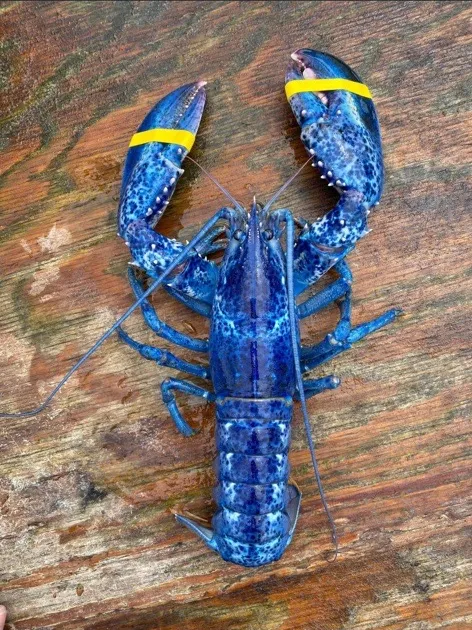

-Speaking of tradition, she's very classically beautiful among Eliksni, with a distinctly Dancer boxy, square headshape. While this was not what was favored in the Golden Age (rounder faceshapes, like seen in House Kings, were favored due to the Traveler's spherical beauty) it's still thought to be quite pretty, especially among Devils. She has mixed feelings about this, because she thinks that valuing beauty over an individual’s strengths is quite shallow, but has used it to her advantage in the past when trying to be charismatic
-The horns she had on Riis pre-Whirlwind were sharp and straight, with two long thicker ones pointing straight back and two smaller ones behind her cheekbones, along with the carapace ridges on her cheekbones having a bit of a point to them. Though all Riisborn Eliksni moulted away their horns to conserve nutrients in the Long Drift, she still has some shallow nubs of carapace that indicated where they were, unlike spaceborn Eliksni that never grew them in without the environmental cues necessary to start their development
-The wound that took out her right eyes was pretty drastic, as she took a dawnblade strike to the face from one of Osiris’s echoes at Twilight Gap. The only reason she survived is because she was not the primary target, so it only nicked her, but the wound melted through her flesh and carapace like a hot knife through butter, and gouged open her sinus cavity as well. To make matters worse, it also got infected after the necrotic tissue was cut away, so the scarring there is…pretty bad. She’s not bothered by the disfigurement, but she does keep it covered as much as possible to prevent people from realizing that she has a weak spot + keep as much shit out of her exposed nasal passage as possible. And also because the back parts of her eye sockets were protected well enough for electrodes to be implanted which connects to sensors in her helmet that buzz when something comes up on her right side, making up for her lack of vision
-Even so, she frequently cocks her head back and forth like a bird to make up for her inability to see on her right side. This is actually canon, but I like to imagine that it's more pronounced when she's calm and not around enemies. Her hearing on that side is much sharper to accommodate her lack of sight as well, so you're not going to sneak up or behind her that easily (as some unruly hatchlings learned the hard way)
-She's big compared to us, but not to other Eliksni of her social status. To them, she's actually pretty fuckin' tiny. Like, 5 foot levels of tiny. Her genetics were not kind to her. She’s also on the more slim side, all wirey muscle with very little fat: if Phylaks was a Titan and Kridis was a Warlock, then she'd be the Hunter of the trio. It caused her health problems in the past re: carrying clutches, but she’s stopped caring about it a long time ago
-She was orphaned at a young age, and part of why she and Athrys had many hatchlings was because they just kept adopting and caring for orphaned or high-intensity care hatchlings. Orphans on Riis were raised communally, with small countryside villages often comprised of 3-4 large families that worked together to share resources, so she had lots of experience helping out her elders with caring for more needy infants. When she and Athrys started their own family, they were the ones in their community who people would go to for advice with premature hatchlings or more sickly infants
-She actually used to know Variks on Riis; he was a teenager/young adult around the time that she was a child, and he used to let her dig through his notes on things she was interested in whenever he visited the Dancers on official scribe business. That she grew into who she was today is something that he bitterly regrets, while his betrayal/perceived weakness is something that she deeply hates him for. He was almost like an older brother or cousin figure to her, so the schism between them is…really personal
-We'd probably place her on the butch scale of things in our society, but among the eliksni side of things she's actually high femme. The thing is that, well...eliksni genders are not really much like ours at all, so that's somewhat arbitrary to her, doubly so because she doesn’t identify entirely as female (canonical she/they Eramis my beloved). I just thought it would be a fun thing to fiddle around with via an intersection of human and eliksni cultures
-Her gender is 'she but in the way you refer to a ship, not a woman'. The Eliksni version of femininity is something that she just kinda accidentally phases into, not something that she actually cares about much. Gender is more of a 'yeah sure whatever' than a 'this is me and you better fucking respect it' thing
-She's one of the very few Eliksni that Taniks trusts and respects. This is because she's one of the very few Eliksni who know that trying to put a leash on Taniks is like trying to tie a silk thread over the jaws of a rabid hyena, so she just lets him do what he wants...as long as it is relatively within reason. She also doesn't try to pull rank over him, or snap at him for disrespect, though she won't let him push her around, as Taniks is wont to do. Other Eliksni think that she's absolutely fucking insane for this
-Athrys was her heartmate, and she’s still not over her. While the company of other Eliksni can come close, and many Eliksni aren’t particularly known for being monogamous, Athrys was different in that the trauma of the Whirlwind and losing their hatchlings along with her just. Turned Eramis completely away from the concept of officially taking another mate. She had a little almost-polycule going on with Phylaks and Kridis, but anytime it started to get more serious, she’d freeze up. It’s not that anyone is trying to replace Athrys; heartmates are kind of like soulmates in Eliksni culture, with the exception that they’re not limited to romance like human culture is, so everyone knew how close they were. It’s more that if she settles into the routine of having a partner again instead of something closer to fwb roommates, she’ll start having flashbacks to the last time she had a mate, and it triggers a depressive episode. To make things worse, Phylaks and Kridis befriended her when they were teenagers on Riis, so her attachment to them is also linked to Athrys (who used to affectionately call them all a band of hooligans)
-Phylaks wanted to have hatchlings with her at one point. The conversation about that…did not go well. Eramis still has those mother instincts going strong, and to be a good Kell among the eliksni used to mean being like a parent to everyone under you (at least, before the Whirlwind), but Eramis cannot think about what it might mean to have more hatchlings of her own without losing it
-Also tying into her gender fuckery, her pining for Athrys, and her thing with Taniks is the fact that they used to be heatmates; I hc Taniks as being the Eliksni variant of bigender, which he only ever felt comfortable revealing to Eramis, while Eramis wanted someone who was the exact opposite of Athrys to share her heats with specifically so that she wouldn’t turn into an emotional mess during it…and Taniks is about as far from Athrys as you can get. It’s kind of a crack headcanon with my friends that this is how Eido came about, lmfao. Though in my iteration, Eramis has zero idea that Eido is her kid, because Taniks was in denial about being gravid until he actually laid the eggs (reminder, in my hcs Eliksni males carry the fertilized eggs in a specialized broodpouch, much like seahorses do), and then he panicked and stuffed them into the vents of a ship he was working on so he wouldn’t have to deal with them later
-She fucking loves citrus- specifically, tangerines and oranges. Its the one thing she actually enjoys among Earth foods, and no, it's not because she's a space pirate. Eliksni don't get scurvy. She just really really likes the taste of them. She is also particularly fond of seafood and organ meats, and though she used to complain endlessly that prey from Sol tasted nothing like that of prey from Riis, you’d be hard-pressed to hear her complain about anything regarding food post-Prison of Elders
-Out of their clutches, almost all were carried by Athrys, because Eramis has issues with carrying clutches to completion. Eliksni can change sex pretty easily, and initially same-sex couples will oftentimes alternate during breeding seasons if they dont find a surrogate, but a mixture of Eramis being small and narrow-waisted meant that her broodpouch never would develop to full capacity when she'd go through a sex-change molt. It's something that she still bears a lot of trauma about, though she hasn't thought about since the Long Drift.
-Lost her lower legs in a ship crash, but that doesn’t impact her mobility much. She’s just as capable of running on all four arms as she would on all sixes if her prosthetics are absent or compromised. It’s not dignified in the slightest, but then again, dignity is something that she gave up on when she got locked into survival mode during the Whirlwind
-Her breathing has a slight snuffly, wheezy sound as a result of the damage to her snout and sinuses, but it's very subtle and doesn't impact her quality of life. It just pisses her off if you comment on it. She also got minor cases of Eliksni pneumonia on Europa after a bad cough that went around in the Prison of Elders got to her as well, so she’s hyperaware and afraid of getting chronic respiratory infections and WILL snap at you if you mention it. There's a reason why her suit covers her spiracles as well as her mouth
-Can cook a handful of generic dishes extremely well and the rest either passable or poorly. This is entirely due to the fact that she used to take cooking and teaching duty for her hatchlings on Riis while Arthys worked, so she memorized a set number of recipes everyone agreed upon and nothing more. She’s hyperaware of the fact that she’s not a cook, but don’t let her into the kitchen regardless she'll hover around and scold you like a middle eastern grandma if she thinks you're not cooking to her standards
-Not very talented on the creative side of things, but absolutely wicked with machines. She can hotwire practically anything in the Sol system in under a minute. The tips of her hands are covered in scars from electrical burns; she and Arthys used to joke that she traded her impulse control for her ability to break apart and rewire any piece of tech she gets her claws on
-She was a strict mother to her and Arthys’s hatchlings, but she was also the quickest to turn her eyes away if they were being mischievous/pulling pranks; that, or she’d join in and make their shenanigans even worse. She imposed and kept rules to keep them safe, but respected their desire to push back against the more arbitrary ones, because she used to be the same way. She’d be tougher with hatchlings she didn’t know, but not in a harsh way, just in a ‘I won’t risk your harm’ sort of way. And if her own kids didn’t play nice with the others, she’d be sure to give them a scolding: her entire shtick is very mamma lion coded, ngl, and that’s a good chunk of why she couldn’t stop herself from caring for Eido during Plunder. She’s essentially been locked into the ‘angry lioness just saw someone kill her cubs right in front of her and now she’s on the warpath’ mode for centuries, and even though she’s tried to snap out of it so as to not seem weak, she hasn’t had much luck
-The name 'Eramis' roughly translates to 'raging storm' in old Eliksni. Anyone who has met her would agree that it's quite an apt description of her
-She's also fond of being squashed while sleeping or cuddling. You'd never expect it, but Eramis, Kell of Darkness is a little spoon. Or, rather, the bottom pancake of the stack. This has waned in favor of her sleeping in front of her loved ones as a guard post-Whirlwind, but despite all her pride about being short, she really does love being compressed, be it by a brood of hatchlings draping over her or her harem curling around her. A weighted blanket would probably absolutely blow her mind
-She doesn’t actually hate humans, though she doesn’t exactly like us either. Eramis is very politically savvy, and she’s very, very good at appealing to the ranks of Eliksni who despise humanity. She hates Guardians and the Vanguard, but she hates the abstraction of their forces and what we represent than humanity as a species
-The Darkness acted like a parasite to her on Europa, and she was its intermediary host (we were its final target). Almost all of her behavior during Beyond Light was the result of centuries of constantly being stuck in fight-or-flight mode paired with the trauma of the Prison of Elders and the euphoria of finally having some measure of power over her own life again being amplified to a dangerous, irrational level by the Witness in order to draw us in to accept its ‘gift’ of Stasis. Being betrayed helped her to snap out of it and come to the realization that she was being used, which is what nuked her anger and had her spiraling into the depression that she’s canonically in right now. She’s burned out the last of her anger, made quicker by the Witness’s torture, and now she’s hollowed out and so, so tired of all the injustices that the universe has to offer her
#prettyflyforahousefly#reply#destiny 2#destiny 2 headcanons#eramis#eramis kell of darkness#eramis the shipstealer#i love her so fucking much
41 notes
·
View notes
Text
#1588: Magical Photography
It seems, me and @espressoristretto-patronum were struck by the same lightning strike of creativity: we needed the old photography.
And the mechanics behind taking a photo when there are barely any artificial lights, and the camera itself looks like a box, weighs quite a lot and requires a tripod to mount it, lest you want to waste a sum of anywhere from 30 to 120 dollars (~$950 to ~$4500 today). Anyway.
I am sure that, over the years, the greater HP fandom has come with their own explanations. Multiple times. Moving pictures are one of the HP's selling features after all; they quite literally cherish old gifs. I haven't read any of those, but I may repeat someone by the sheer accident of a thought being simple will visit many heads.
The post is going to be long-ish.
To put photography super simple: a photo is an impression left by the light that gets captured on the camera's photosensitive: 1) matrix, if it's a digital camera, 2) film, plate, or paper, if it's an analog camera.
In digital cameras, that impression is coded a certain way and stored as a file on the memory card. Our stories and HP itself don't present the technology at all, so I will not discuss it much.
In analog cameras, you may say, the impression of light is captured by exposing silver halides, or similar material, to something well-lit.
Both kinds of cameras require being exposed to the light for a period of time. This period is called exposure time. The more light camera receives, the more visual information it gathers and is able to etch on to the surface of its unit of storage. Short exposure times are most excellent if there is a sufficient amount of light, and long exposure times will be the best option for if you are capturing something that emits a very little amount of light (e.g. night sky).
The need for continuos exposure of light can be somewhat mitigated by using ISO(=increasing light sensitivity of the sensor) in the digital cameras:

But if you can use exposure, i.e. provide enough light per unit area, enough lux, better use that. Analog cameras, as you likely notice by now, can't afford any such luxuries.
Analog photography requires a set-up for two reasons:
memory capacity is dictated by what you literally have on hand to store the latent images—plates, papers, or rolls of film—and these options are often costly to make anew;
too little or too much light are not valid options, there is only one and it's called Enough Lux.
Then, it all depends on the kind of the camera. For the sake of our timeline—1900s—I'm not going to mention something old-school. Instead, I will thoroughly mention graveyard.
Many of the old cameras followed the design of the camera obscura and rarely had lenses made in accordance of the principles of optics.
The old camera is typically two boxes: 1) the front box has in-built lens that can be capped, 2) the read box could slide back and forth and had the ground glass aka focusing screen: a matted glass plate mounted at the face of the box on which the image from the front was projected laterally reversed (i.e. upside down).
An additional prism or lens could be installed to flip the image, but it wasn't strictly necessary. By sliding the box, the image was brought in to the camera focus—appeared sharp on the screen. The infamous photographer's cloak was needed precisely to help the man focus the image as otherwise it was nearly impossible to see it in the daylight.
The photosensitive material, usually a plate, is installed afterwards. The cap on the lens acts like a shutter.
The film (or plate, like in daguerrotype, or paper, let's say, Bayard or calotype) then must be processed to render it insensitive to light.
The development of the photosensitive materials went hand in hand with the evolution of cameras. Not all cameras were as simple, if not to say crude; going forward, they became more and more advanced, as shorter exposure times were desired, so was the need for different focal ratios (the ability to control the amount of light on the sensor).
The Camera that we are all familiar with does not appear until 1930s.
With that in mind, to reconstruct a possible kind of camera used by the wizards, we should keep in mind that those would be huge and cumbersome apparatuses mounted on tripods.
So this image of Ranrok from the beginning of the game:
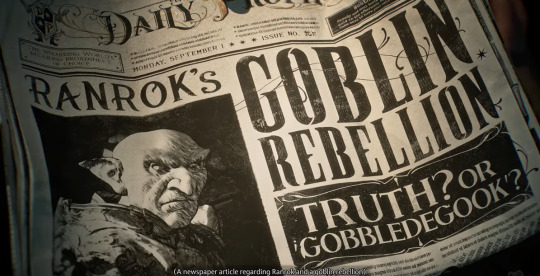
was captured with something like this:


and put to paper likely using a variation of halftone or photogravure; woodcut could do, too.
I'm not overly familiar with the contemporary printing techniques. Will read on them.
Today, organising a set-up like this isn't impossible even if you take your photos with the authentic cameras from two centuries ago. But how was it for people living back then?
I went very in-depth and in-detail. It is needed to draw a picture, or an approximation of it, before I can theorise anything about the wizards. I have a headcanon, yes, but it is not easy to put to concise wording without an atrociously long exposition to the topic of the early photography.
So.
The technology being was it was—crude at the wee hours of its dawn—left many to their own devices. Organising the process and getting the materials and the room, as well as the fact many photographers processed their photos themselves, rendered photography quite a prosperous business venue—if you could afford everything needed for it and could keep up with both the demand of a client and the process itself. It was ridiculously tiresome and hazardous, cumbrous even for something so monotonous and simple.
Besides, early photography was also notoriously long. Anywhere from few seconds to nearly an hour, depending on the intensity of the light and whether if you had fallen asleep or yawned or shuddered.
Hours long exposition was the thing in the landscape photography, that includes city photography. By today's standards, 5 seconds is a lot. But in the 1800s, it would've been considered incredibly quick!
Early techniques used photosensitive materials of poor sensitivity. This is why you'd commonly spend around few minutes before the camera lens: light needed to leave strong enough impression on the plate.
The main source of light was the Sun. Just making windows larger was not enough. The entire room was transformed or constructed in a form of a greenhouse to accommodate the camera's design and the plate's poor light-catching qualities. This set-up, established in the 1840s followed the overwhelming popularity of the daguerrotypes, had remained barely touched or changed until the 1860s.
Usually, it would something like this:

Obvious it is that the working process was dictated by the weather. Inconvenient, to say the least, and bankruptcy for an average brit. Exposure time was also, as I said, long. Long. Up to 30 minutes long.
Up to 30 minuted in the direct sunlight put through glass. People tanned while taking photos sometimes. If you've wondered why people on the old photos are uncanny and serious, this is one of the reasons why. In addition to that, if you move after the exposure has been set…
Long-exposure photos are quite popular today. You can use longer exposure to create effects like motion blur and many others.
Few examples, (c) Boarsart:
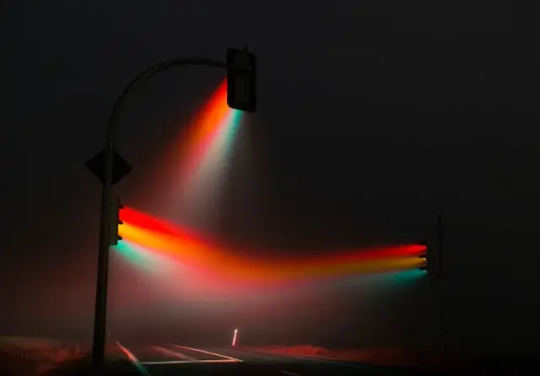



Allow yours truly to contribute to the bit with this crappy shot of the mouse light shaken near the lens:
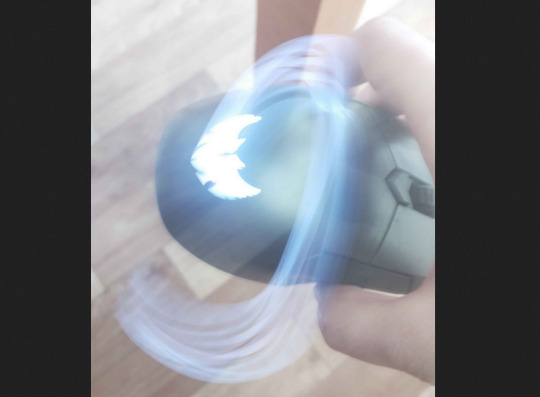
But if you are shooting a single family portrait for 30 minutes straight (and nobody can move), any such effect will be catastrophic. It is not as much of an issue for the photographies recorded in film (by the time it is film, the photos are also taken much faster) but if you are making a daguerreotype—you are going to ruin it.
By the way: the "ghosts" on the photographs are caused by this effect. How it happens? Imagine exposure not only as gathering light thing, but as layering with transparent paints except you are also able to layer light on top of dark—because it's light theory, not colour theory. Anything you add to the solid foundation will be translucent. Therefore, if you have appeared mid-shoot, your figure would appear ghostly on the final photo—or not seen at all if your clothes blend with the background too much.
But don't worry. People couldn't give in into the slumber for long. To keep them straight and well-posed, other people invented yet another Victorian torture device: head-rests!



These beasts weighed tens of kilograms and had to be moved and recalibrated to fit each new customer manually. People were quite afraid of these things, hence the caricature from above (I believe, it's from Punch?). To shorten the exposure time, some photographers even applied white powders, like flour, on their clients' faces, as white reflects most light, therefore, it appears brighter. Can also explain the Perfect Skin people from the old photos often have.
Sitting underneath direct sunlight wasn't pleasant for the eyes either.
The photo room is commonly at the roof, has white or pastel-colour walls, and look much like a greenhouse. The light is blindingly bright. How to solve… this, somewhat, at least? Install blue-tinted windows! It's actinic anyway—meaning, affecting the photochemical reaction—and the daguerrotype plate is sensitive to light at the blue end of the spectrum, only barely affects the exposure time, and simultaneously keeps the client's eyes relatively unstrained. Don't worry though, they could blink. If you are supposed to sit before a camera for more than even 5 seconds, a blink wouldn't be registered. It's too fast to catch.
Atrocious exposure times were also the reason why people preferred to sit during the shooting.
By the time it's 1850s, something needed to change.
Sunlight was a terrible source of light. The entire work process is tied to the vagaries of the weather. Daguerrotypes, albeit photosensitive, weren't terrific at it at all. Not only that: they were hazardous. Fixing—the post-process, if you will—required the person working with the negatives to work with mercury vapours as it was the method of de-sentification the plates to light. As a result, many people died from the effects of the mercury poisoning in the years following the boom of daguerrotype photography. But it wasn't the main reason why the daguerrotypes were soon to be replaced with the ambrotypes and ferrotypes.
Underexposure was the deal-breaker for daguerrotype photography. It didn't solve this issue, nor offered solutions, neither was cheap enough to keep going. To make a plate for this kind of photography, you need an amalgam of (preferably) pure silver and copper or brass. It's too expensive in the long run. And it goes without saying to suppose it was a quest to replicate an image from the daguerrotype.
The replacement for it had already been introduced but but before the faster wet collodion methods, ambrotype and ferrotype, could take over (either was as sharp as the daguerrotype whilst requiring a lot less maintenance and possessing the duplicability of calotype), photographers needed to find sources of the artificial light.
Said light, however, with technology at hand, ought to be in the blue part of the spectrum. Anything like kerosene lamps—a very new thing at the time yet taking over the market at a rapid pace as it was the replacement for candles—couldn't be used; the light of the kerosene lamp is in the red part of the spectrum.
Photographers tried candlelight. Weak and insufficient source of light. Some tried the Drummond light—limelight—as it was super bright and was widely used in theaters and music halls. At the start of the 19th century some even suggested to use it for street illumination but… This is how the limelight looks like:


A piece of calcium carbonate, usually in cylindrical form, is skewered on the thin rod on top. To make it candescent, flame was required, and was put directly at the piece whilst it has been continuously rotated. Besides, the piece was not burning away evenly and required an abysmal amount hydrogen gas. You can change it for the coal gas, also known as the town gas, or for acetylene. Either way, you are stuck with a highly flammable and agressive chemical reaction.
The size of the piece was also a huge problem. It was too big to be safely and effectively utilised for this purpose. Look at the packaging:
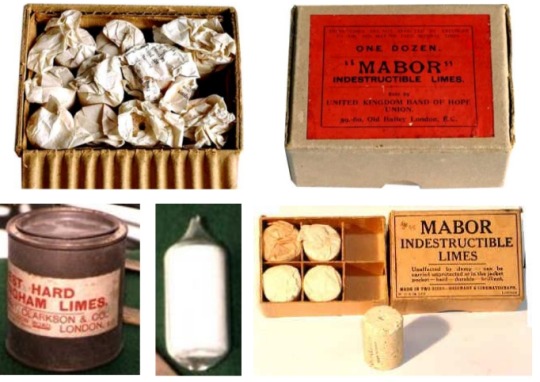

So. The limelight is expensive. Needed additional pair of hands. Could engulf the entire studio with uncontrollable flames and take down the entire building with it—not to mention mercury. You don't want mercury vapours raw—and certainly don't desire them travelling around the city block trapped in a thick cloud of smoke.
The photographs made with the limelight were overexposed and had "chalky" look to them. Photographers couldn't really stick to it. Yet, it was used occasionally up until the 1860s because it was still light and the clients have paid for the session.
If you had ever seen or felt the intensity of a scoop light, limelights are as blinding. Daylight or this, for so a lot of decades, was the only choice besides the option of refusing to make photo of themselves for many people (it sounds quite dramatic; taking a photo wasn't formidably expensive for most people but depended on the kind of the technology involved; the daguerrotype would be more expensive (silver) than an ambrotype (glass) or a ferrotype (iron sheet), or a calotype (paper)).
There were other attempts to introduce chemical sources of light to the process but neither could provide the necessary amount of blue, nor they were sufficient light sources.
I have mentioned 1860s a few times. What happens in the 1860s?
The invention of magnesium wire.
Its light is highly actinic and it's continuous. Magnesium wires were used to take photos of the catacombs of Rome in the late 1860s—to give an indication of just how bright they can be:

It was the breakthrough.
But magnesium introduced few new troubles. First off, staring at the wire could hurt the eyes. Second, the wire was prone to fuming and snuffing itself; dousing it in water could cause it to burn even brighter due to the reaction with hydrogen in the water's vapour. Thirdly, that thing blasted like gunshots.
It is then when you see the change in postures on the old photos, too. People could stand! (c) photos. A jardinière becomes a Very Important Decorum:

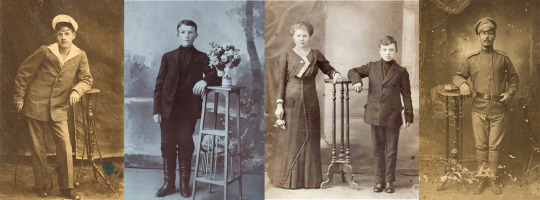
Flattening the wire, developing the special casings for it, performing the shooting in synch with the burning helped a bit but now it was too much uncontrollable light.
To mitigate this whilst still providing enough lux, magnesium flash was developed after the few years of unsuccessful tries. We know this flash under another name: the flash-powder.
It was usually a mix of potassium perchlorate and magnesium, but PP could've been replaced with 1) nitrates of barium, thorium, or ammonium, 2) or with potassium permanganate. Sometimes, sulfur was added (you don't want to do that, it's not gunpowder!!!).
If you supposed the new solution introduced storage complications, spontaneous combustion and smoke clouds enshrouding the sitters, you are most correct. Photographers were granted mobility in their work to escape dinner parties before guests could realise their gowns and food were coated in grime. The flash itself was also quite loud:
youtube
The flash-powder had remained in use until well into the 1960s.
Cheap, quick, serving its purpose well until electric flashes eventually came to replace it. Albeit, the flash gives a very soft light; we struggle to replicate it with safer alternatives today, believe it or not.
Flash-powder was also a cheaper option between it and the flashbulb used in the analog cameras we know circa 1930. The bulb had been rapidly modified and worked on since, as the first examples of this technology were single-use items. And, you know. Flashbulbs.
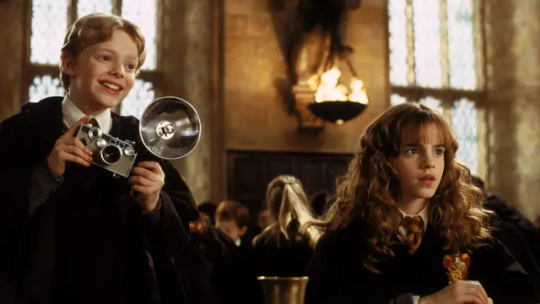
Colin's camera is an indication that analog cameras can be used in the wizarding world. Especially the older cameras, the box-n'-box, something like Thornton Pickard, Houghton's Midg or the Brownie.
All of these use something called gelatin silver print as a unit of storage—in other, more familiar words, it is the Kodak film we all know and remember (hopefully; please tell me we are all old farts).
It was lousy of me not to mention what were exactly these many -types of photography and photographs. They are all based on the two discoveries that made photography even possible: 1) camera obscura that has been known c.5 century B.C. and 2) photosensitivity of the silver nitrate (when powdered and exposed to sun, turns black as ink), discovered in 1614 by Angelo Sala. So, what are these:
1839-1856: daguerrotypes. Required polished-to-mirror-finish sheets of silver-platted copper or brass. Needed to be exposed to a source of light, could take seconds, could claim tens of minutes. The latent image is only visible when exposed to mercury vapours for a few minutes; could've been entirely avoided by exposing the plates to the sun after covering them with red or yellow colour filter but was rarely if at all done due to the process taking at least a day. Besides, the image could appear as both negative and positive if viewed at different angles but only under specific light. Fixing is done by a rinsing with fixer and and in auric chloride. The plate is then sealed behind glass. Expensive and lengthy process.
1856-mid1860s: ambrotype. Glass plate is the base material. One side is coated with a thin layer of collodion and then dipped in the silver nitrate—so it will stick to the glass. Then the plate is exposed for a time necessary, but quick enough to avoid over-exposition or drying. Remove, develop, fix. The back of the ambrotype image was usually covered with something black: lacquer or cloth—done to highlight the opaque areas that appear lighter when viewed against the dark background. The glass used could be tinted. The resulting negative is always positive image and can be seen under any light. Cheaper and slightly shorter in comparison.
1860s-mid1950s: ferrotype. Basically, ambrotype, but the base material is a thin sheet of iron. Eventually, replaced ambrotype photography due to the flaking of the ambrotype images. Before the glass for ambrotype would be ready, it required a thorough cleaning to degrease it. Iron for a ferrotype was a lot easier to prepare, it was faster to shoot with, to fix and develop it and seal the resulting image. All could take just few minutes. Inexpensive and fast option.
1890s—nowadays: kodak film gelatin silver print. Insanely long-lasting, incredibly photosensitive, an absolute winner.
Essentially, all use silver and a some kind of emulsion to stabilise it for a period of time, enough to capture something. Now that I wrote all this,
my headcanon.
Wizarding photography as we know it really took off only after the flash-powder was made. In muggle photography, the flash creates enough light to leave an impression.
Wizards are different. They do not capture light. Instead, they expose a kind of unit of storage but for magic readings and call it exposure.
Too much magical impression—which I can characterise as nothing less than magical residue left by any soul and particle of the universe—"corrupts" the film. This is why magical photography is usually few seconds long, but can also act like a normal magical painting. Sometimes.
So, why using the flash?
It blinds the magic. It is also too much magic. An overload or better say, over-exposition. The first ever photo made with the flash was thought to be ruined but…
Magnesium is an element alchemists supposed being able to burn if not forever, then persistently. They also thought it was used in the process of making the Philosopher's Stone. What if you add sulphur to it, too?
The magic has been rejuvenated but kept repeats itself an infinite number of times after has been hit with a sulfur-magnesium flash; it's imposed a some kind of self-circuiting behaviour that allows it to just flash the same scene over and over again. It is persistent, at least.
phew
That should be all. I might return to this post to review it in the future and maybe clean up details here and there and add clarity. Hope it was informative. Oh and there was a guy in 1901. He was measuring the heights of the Moon's mountains. I forgot to mention.
14 notes
·
View notes
Text
Pilot Rejection Syndrome
The screening of new pilots is extensive- some would say to the point of paranoia- but even with it, mistakes still happen. Those tend to shut the ones advocating for deregulation up for a while. When the manuals describe Pilot Rejection Syndrome, the metaphors they use are medical- that its analogous to a tissue graft fighting against the host. And this, strictly speaking, isn't inaccurate. The neural feedback certainly damages the tissue of both the mech and the pilot.
But its not the entire truth.
A more accurate metaphor would a breakup.
Why keep it a secret? Well, when its a brand new pilot involved, the damage is usually minimal. Some minor memory editing and some implants to compensate for the damage, and your pilot is ready to have their compatibility re-tested and to be assigned a new mech. The old one just needs some wires replaced. All in all, its a very fixable problem, assuming the sensors pick up on it early- and they do, because they're always running for the first interfacing. The real issues, the ones that make the news? Well, everyone knows that a mech and its pilot grow together over time, almost literally. And these assets are some of the most valuable in the fleet. Unless you do something stupid like try and separate them, they're also some of the most stable. Except... while its assumed that they'll grow together, relationships are hard. Its possible for them to grow apart from each other instead. And when they cross the compatibility threshold on the front, or in space? No scanner is going to be looking out for that. So you've got a messy breakup, with no one capable of getting the two apart from each other, between two incredibly skilled assets. That's the kind of thing that makes the papers. The damage is a hell of a lot more widespread than just some fried nerves in a hopeful newbie. Of course, telling pilots this slows the bonding process down considerably... so its deemed an acceptable risk. Even the one's who hear about it in rumors assume that it couldn't possible happen to them.
Trust me. I of all people would know.
385 notes
·
View notes
Text
Want an object where it's not just socially acceptable to intimately touch, but even codified as a rule that you need to do every time? And in some cases the rule is you need to kiss a certain part of it to determine if it's safe?
Try a small four seater airplane like a Piper Warrior or a Cessna 172 Skyhawk! Preflighting is critically important to every single airplane prior to flight and involves running your hand across the plane's skin, moving the ailerons and elevators up and down manually, feeling the tire pressure through your boot, and for those more kinky minded, checking the fuel/removing impurities, with one particular method synergizing well for some kinks.
Also for Cessna 172s, although there is equipment to do this cleanly without using your actual mouth, the traditional method to check the stall warning horn is to put your mouth over a certain analog sensor on the left wing and kiss/suck on it.
Cons: flight training is expensive, and individual airplanes even more so
Pros: you can see why the joke is that most pilots want to fuck those things
#objectum#i have some flight training to my name but it's currently on hold until i make more money#however i am sadly not attracted romantically to planes#i see em more as family#my heart only moves for buildings
7 notes
·
View notes
Note
Tango is very excited about android!Joel's new upgrades. The synthetic flesh is cutting edge technology! He isn't certified to work with it (yet), but he is already rearranging his schedule to fit in the required classes. Give him a few months. There's no way he's gonna leave his favorite client hanging. He's looking over Joel and babbling about all the little details (there are little hairs on his forearm! they gave him fingerprints! and they're angular, wait is that circuitry? did they upgrade the touch-sensors on Joel's fingertips? this is so amazing, Tango is so fascinated).
Meanwhile, Joel is just trying to Not show how relieved and distracted he is. He had been afraid that Tango wouldn't want to see him anymore now that he was ... different. But it seems like Tango might want to see him even more now. Joel's not sure how he feels about that yet, but he's definitely sure he'd rather have Tango work on him than the Company mechanic (maybe Doc can work something out?).
And it's strange, and nice, how different it is to feel Tango's hands on him now, with all the new sensory inputs he's capable of. It was one thing to know that Tango's work put callouses on his hands, and another to feel the roughness of them moving over Joel's new skin. It was one thing to measure Tango's body temperature, to know he ran a bit hotter than the standard human baseline, and quite another to feel how very warm he was. (And how these sensations were interacting with his emotional response centers was something he would definitely have to analyze. Extensively. Later.)
Joel is grateful that Tango is too busy being impressed by his upgrades to notice him zoning out while Tango holds his hand. Maybe it's a good thing that he can't blush.
-500w🧡
It's hard to not catch Tango's excitement over his new body. Joel himself was pumped about his upgrades, it was just dulled by coming back to work. Especially after the diagnostic by company mechanic (error: memory-5987974279 cannot be deleted: unauthorized access). It was a great relief to finally know that the worst outcome didn't come true. Tango even wants to get licensed to still be able to work on him! But Joel was most definitely overwhelmed by how tactile he was. Tango definitely a very physical person and he felt every touch as if it was electric. Tango traced along Joel’s new body, that was slowly gaining strength, stretchy analog of what organic beings would call muscles and more sturdy carcass that is supposed to imitate bones. Artificial blood still was flowing through his veins and it all was hidden under a protective and sensitive tissue that was synthetic skin. It all responded to Tango's warm and rough hands. Joel could actually feel their texture and temperature and how he had trouble regulating his grip with it being either very strong or pretty loose.
He couldn’t put it to words what exactly he thought about Tango's newborn hardly contained excitement and interest in his body. On one hand, he felt somewhat dirty, he knew, he knew Tango is different, that Tango cares and he doesn't want Joel here exclusively for this new technological upgrade. But something (error: memory-5987974279 cannot be deleted: unauthorized access; error: fixated emotional instability: stress level 87%) was nagging him about it, told him to stay away while he can (error: memory-5987974279 status cannot be altered: unauthorized access). It was making feel less alive. But on the other hand it made him feel special, at least to Tango. It made him feel warmer.
And the feelings from emotional responses he will review later. Sometime.
14 notes
·
View notes
Text
tbh rather than anything to do with waterproofing, I'd wager the reason so many Big Brand™ phones did away with the earphone jack had far more to do with lifestyle marketing for bluetooth headsets and the ability to cheap out on the internal DAC.
Basically, to transform digital signals into audible sound, you need some way to convert digital values into some kind of analogue signal, hence a digital-to-analog converter, or DAC; and if you want higher quality sound, you generally also want a higher resolution DAC to generate a clearer and more accurate signal. However, if all you have are the built in speakers, then the amount of discernable audio quality is going to be rather limited, meaning you could easily skimp on the DAC without really losing anything - with bluetooth etc being all digital transmissions, the cost of a good DAC can effectively be outsourced to whatever headset or speakers you might be using with your phone instead.
It's a lot like how many modern appliances and such have taken to use capacitive touch sensors to sell you on the idea that them cheapening out on their products is actually a mark of quality.
12 notes
·
View notes
Text
State-of-the-art technology helps monitor Amazon air and biodiversity

The song of birds. The ruffling of leaves as the jaguar prowls through the jungle. The communication between pirarucu fish swimming in the river. Deep in the Amazon forest, sounds come together to form an orchestra. Even untrained ears can appreciate the symphony. However, if one of its instruments goes off-key or its music comes to a halt, the dissonance is just as evident.
The analogy between music and biodiversity in the Amazon was drawn by biologist Emiliano Ramalho, 46, who has lived in the forest for over two decades. It is the best way he has found to explain how the continuous monitoring of animals helps assess the dynamics of the ecosystem and stay alert for any red flags.
Ramalho is the technical and scientific director of the Mamirauá Sustainable Development Institute, in the city of Tefé, Amazonas state, an entity linked to Brazil’s Ministry of Science, Technology, and Innovation. Since 2016, he has been at the helm of the Providence Project, which uses automated sound and image systems to study Amazon species. Over 40 sensors are spread throughout the forest, active 24/7.
“Through technology, we get to observe a number of species and behavior types we’d never be able to monitor by natural means. It completely changes the way we look at the fauna. Technology won’t keep us from having to do fieldwork, but it does serve as a kind of seventh sense for us,” he argued.
Continue reading.
#brazil#brazilian politics#politics#environmentalism#science#good news#amazon rainforest#image description in alt#mod nise da silveira
13 notes
·
View notes
Text

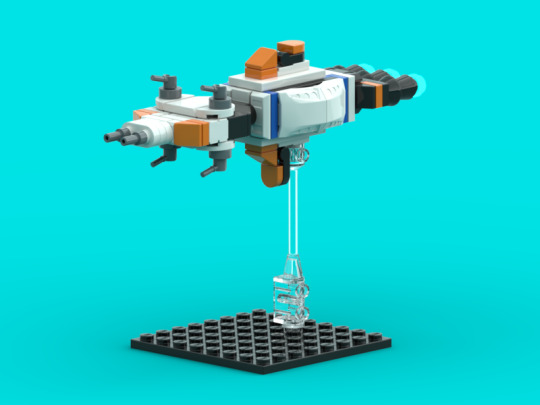
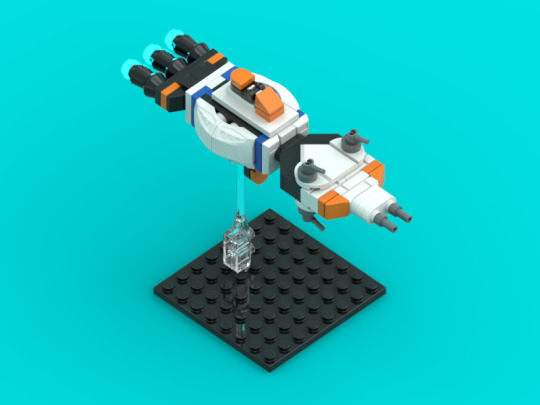

The Evace (Eee Vee Ace) class light cruiser, despite its relatively small size, is the largest dedicated warship, capital or otherwise, produced by the Galatea Shipyards of the First Great Expansion colony system, Acis. The light cruiser isn't the most imposing capital ship, but its the pride and joy of the shipyards and a thorn in the side of Dramstellar whose profit margins are cut into by on the regular. At distance, the Evace class's profile could easily be mistaken for a large frigate, and the triple engine configuration doesn't help. These engines are powerful for their compact size however, and rival more traditional, larger capital ship engines. The engines serve as an excellent analog for the class overall in fact; compact, dense, and bristling with energy. Most of that energy is expelled in an ever expanding sphere as electrons, photons, and other more exotic forms through the vessel's plentiful AESAs, LADAR, and other more exotic sensors. Far less of that energy is concentrated into accelerating missiles through the dual bow mounted casaba howitzers, though the return on investment is truly impressive when the individual missiles detonate their internal fusion bottles to pump a shotgun blast of ludicrous speed particles in a target at distance. The four PDGs are almost mundane by comparison to the rest of the ship systems, leading to rumors that Acis may be reverse engineering Ijad technology in direct violation of Ionian law. Naturally, no such evidence has ever arisen. Perhaps more concerning are the number that have appeared in recent years in the private fleets of more... erratic megacorps, including two in the forces of the Krewstara Consortium who have become outright free colonists opposed directly to Dramstellar's interests. The more savvy naval analysts suspect the Evace class represents not a smaller ship punching above its weight class, but potentially the first in a new wave of miniaturized, yet no less lethal, purpose built ships of war.
#lego#mf0#mfz#mobile frame zero#bricklink#lego studio#digital art#spaceship#starship#imaginary starships#Intercept Orbit#lego ship
32 notes
·
View notes